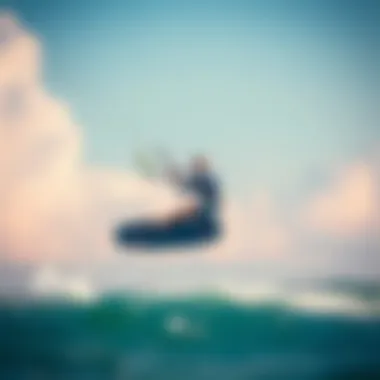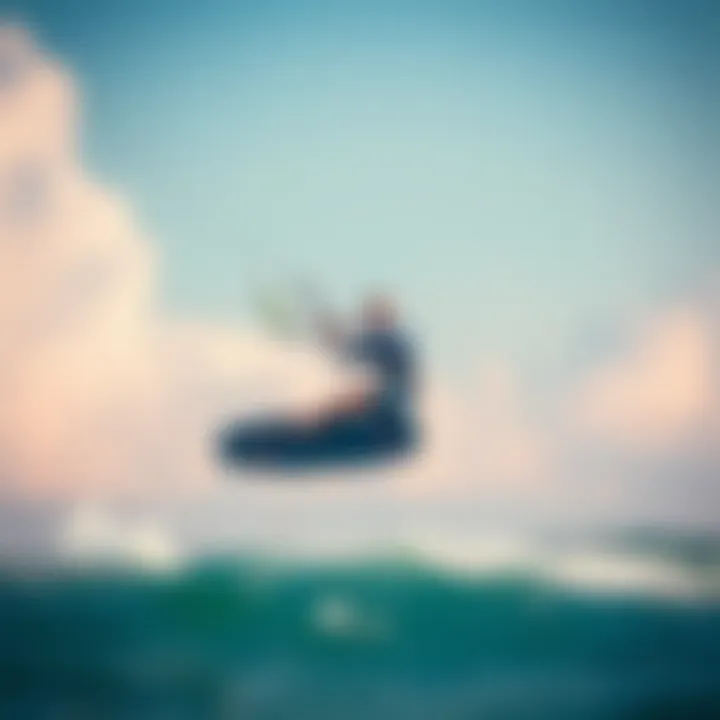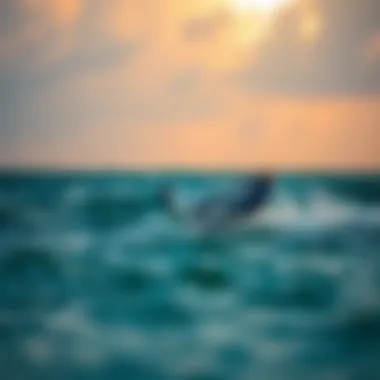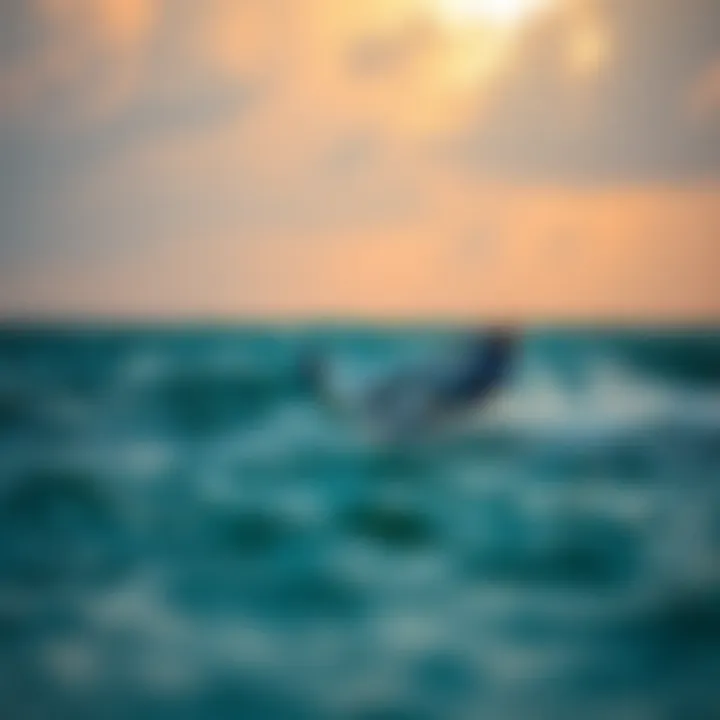Kiteboarding in Watamu: A Complete Guide


Intro
Watamu, a small coastal town along the Kenyan shoreline, beckons kiteboarding enthusiasts with its alluring winds and stunning marine backdrop. Image yourself gliding over the turquoise waters, the sun kissing your skin, and the thrill of the wind in your sails. It's an experience few places can mimic, making Watamu a haven for both beginners and seasoned pros alike.
The geography of Watamu is tailor-made for this exhilarating sport. With consistent trade winds blowing and expansive, shallow lagoons, kiteboarders can navigate the waters safely, enjoying both the thrill and serenity that the ocean offers. Diving deeper into the nuances of kiteboarding here requires understanding not only the local conditions but also how to best equip yourself, regardless of whether you're just starting or looking to refine your advanced skills.
In this guide, we’ll traverse through the essentials: the best gear tailored to your skill level, techniques to hone your kiteboarding prowess, and travel tips to make your journey to Watamu smooth. Whether you're here for a week or planning an extended stay, this guide serves as your compass to fully embrace the kiteboarding culture while exploring the sublime beauty of Watamu.
Putting it simply, Kiteboarding in Watamu isn’t just a sport; it's an enriching adventure that embraces the spirit of the wind and the waves.
Prelims to Watamu
In the realm of kiteboarding, few destinations stand out quite like Watamu, located along Kenya’s captivating coastline. This picturesque town not only attracts thrill-seekers but also nature enthusiasts and those interested in immersing themselves in a vibrant local culture. By introducing Watamu, we set the stage for understanding why this location is a mecca for kiteboarding aficionados.
Geographical Overview
Watamu boasts a unique geographical configuration that significantly shapes its kiteboarding landscape. Situated on the southern edge of the Malindi Marine National Park, the town enjoys a blend of stunning beaches and coral reefs that provide both shelter and scenery. Its tropical climate means consistent temperatures throughout the year, which creates an ideal setting for water sports. The prevailing trade winds blow primarily from the southeast, particularly during the kiteboarding season from May to September.
The strategic positioning between the Indian Ocean and the surrounding landforms produces an interplay of winds that beginner and expert kiteboarders alike appreciate. In addition, there are various shallow areas along the coastline, offering safe spots for practice and exploration. Those venturing into the waters can often find themselves surrounded by vibrant marine life, adding an extra layer of excitement to each session.
Overall, the geographical attributes of Watamu render it not just another surf-and-sun destination; it becomes a playground for enthusiasts.
History and Cultural Significance
Digging deeper into Watamu’s roots reveals layers of history and cultural richness that enhance its appeal as more than just a kiteboarding haven. Initially inhabited by the Swahili, the town has a history steeped in trade and interaction with various cultures over centuries. The ancient town demonstrates influences from Arab, Portuguese, and British traders, each leaving their mark on the local traditions and ways of life.
Moreover, the importance of the ocean to the local communities has fostered a profound respect for marine conservation. This culture of sustainability is vital, as it helps protect marine ecosystems that kiteboarders enjoy today. Community festivals and local dishes reflect an intertwining of history and modernity, where the past dances harmoniously with the present.
Therefore, understanding Watamu’s history and cultural significance not only enriches the kiteboarding experience but also connects enthusiasts to the roots of the place they are visiting- showing them that every ride on the waves is part of a broader narrative that stretches back generations.
Kiteboarding Conditions in Watamu
Kiteboarding in Watamu is not just a hobby; it's a thrilling pursuit fueled by nature's finest elements. Understanding the kiteboarding conditions here is essential for both seasoned kiteboarders and those just dipping their toes into the sport. The unique environmental factors, particularly the wind patterns and water conditions, create a haven for enthusiasts aiming to ride the waves and catch the wind in a spectacular setting. With miles of stunning beaches and the gentle embrace of the Indian Ocean, the conditions in Watamu help cultivate an unforgettable kiteboarding experience.
Wind Patterns and Timing
The wind in Watamu behaves like an eager companion, always ready to help kiteboarders reach new heights. The consistent sea breezes, which typically range from 15 to 25 knots, make this location highly desirable. Most kiteboarders find that the winds blow strongest from June to September, coinciding with the annual easterly trade winds. However, the period from December to March also offers good conditions for kiteboarding.
Tips for reading wind patterns include:
- Mornings are generally calm: Early risers can enjoy a quiet session as the winds build up.
- Afternoons bring stronger gusts: As the temperatures rise, the winds kick in, providing an exhilarating ride when the sun is high.
- Watch for local weather reports: Keeping an eye on the wind forecast via local sites or apps will help you time your sessions for the best experience.
- Observe other kiteboarders: Noticing where and when experienced locals take to the water can offer insights into current conditions.
Maximizing your time on the water hinges not only on seeking out the right winds but also understanding the significance of timing. Kiteboarding is best enjoyed when one is attuned to these natural shifts, making it paramount to plan trips around peak wind periods. As any kiteboarding aficionado will tell you, local knowledge is invaluable.
Water Conditions and Tides
The waters off Watamu are as inviting as they are crucial for the sport. With its crystal-clear lagoons and plethora of reef structures, the area caters to all skill levels, from beginners to the more adventurous ones. When considering water conditions, factors such as tide schedules, wave formations, and reef configurations play a significant role.
Key points about water conditions include:
- Lagoons offer calm waters: During high tide, the lagoons are perfectly flat, creating ideal conditions for those just getting started.
- Wind-driven waves: As tides shift, the sea becomes livelier; seasoned riders can capitalize on this for a more challenging experience.
- Reef awareness: While the reefs can create spectacular breaks, they also require caution, especially for less experienced kiteboarders. Understanding the layout and timing of waves is crucial to safely enjoying the sport.
- Safety Precautions: Always wear a life jacket and be mindful of the changing tides. Knowing when to be in and out of the water can help avoid any dangerous situations.
In summary, the kiteboarding conditions in Watamu are robust and diverse, presenting opportunities that cater to various skill levels. By comprehensively understanding the wind and water conditions, kiteboarders can enhance their experience, making the most of this remarkable surf haven.
Best Kiteboarding Spots in Watamu
When it comes to kiteboarding, choosing the right spot can be the difference between a glorious ride and a frustrating day. Watamu, with its breathtaking landscapes and optimal wind conditions, is a gem for kiteboarders of all levels. Whether you are a seasoned pro or just dipping your toes in the water, the diverse offering of kiteboarding locations in Watamu ensures everyone finds their niche.


The classic combination of reliable winds, spacious beaches, and relatively shallow waters create an ideal playground for adrenaline seekers. Each beach carries its own character and challenges, making it essential to understand these spots to maximize your experience. Here’s a breakdown of three standout locations you shouldn’t miss.
Watamu Beach
Watamu Beach stands out not only for its stunning turquoise waters but also for its consistent winds and manageable waves, perfect for kiteboarding. The beach stretches over a vast expanse, allowing kiteboarders plenty of room to take off, land, and practice their skills safely.
- Wind Conditions: You can expect strong winds from June to September, making this the peak season for kiteboarding enthusiasts.
- Accessibility: The shore is easily accessible, with several local shops renting equipment nearby. Plus, you can find instructors offering lessons for beginners.
Don’t forget to snap some photos of the beautiful coral reefs just off the shore—they're a spectacular sight!
Kenyatta Beach
A bit more laid-back than Watamu Beach, Kenyatta Beach provides a welcoming atmosphere for kiteboarders looking to enjoy both leisure and sport. The calm water is advantageous for those who prefer practicing tricks and enjoying a relaxed ride.
- Family-Friendly: This beach tends to be less crowded, making it ideal for families or those looking for a quieter experience.
- Local Vibe: The beach is dotted with local cafes and shacks where you can grab a bite after a session. Sipping on fresh coconut water while listening to local music is a treat.
Each session here brings serenity, and with the right wind, you'll find the waves beckoning you.
Turtle Bay
Turtle Bay is perhaps one of Watamu's most picturesque spots, and it’s not just the name that makes it unique. The shallow waters and extensive stretches of beach make it an ideal hub for both beginners and advanced kiteboarders.
- Natural Beauty: It's hard to beat the view—you can spot various marine life, including turtles, just beneath the surface.
- Safety: The presence of lifeguards adds a layer of safety for those who are still learning the ropes.
Additionally, the atmosphere here is vibrant, with plenty of locals and fellow tourists mingling, perfect for a social outing after a day on the water.
Finale
Each of these kiteboarding spots in Watamu offers its own unique flavor and advantages. Whether you prefer the bustling vibe of Watamu Beach, the peacefulness of Kenyatta Beach, or the scenic allure of Turtle Bay, there’s a piece of paradise awaiting every kiteboarding enthusiast. Don't forget to respect local regulations and embrace the natural beauty that surrounds you!
"Kiteboarding in Watamu isn’t just about the sport; it’s about capturing the essence of nature and thrill in one ride."
Explore and enjoy!
Equipment Essentials for Kiteboarding
Kiteboarding offers an exhilarating blend of wind, water, and skill, but at the heart of this sport lies the essential equipment that can make or break your experience. Selecting the right gear not only ensures safety but also enhances performance, allowing enthusiasts to fully enjoy what Watamu has to offer. From kites to boards, and safety gear, let’s break down why understanding your equipment is a cornerstone of kiteboarding success.
Choosing the Right Kite
When it comes to kiteboarding, the kite is your lifeline. It’s the primary tool that interacts with the wind – without the right one, you could be battling against the very element that should be your ally. Consider several factors when selecting a kite:
- Size: The size of the kite often correlates with wind conditions and your weight. In lighter winds, larger kites generate more power. Conversely, in strong winds, a smaller kite offers better control and safety.
- Type: Choose between designs such as inflatable or foil kites. Inflatable kites are popular for beginners, offering stability and ease of use. Foil kites, on the other hand, are more efficient in lighter winds but require specific handling skills.
- Wind Range: Ensure the kite’s wind range matches the typical wind conditions in Watamu. Knowledge of average wind speeds will help you make an informed decision.
It’s worth noting that brand reputation can guide your purchasing choices. Consider models from trusted manufacturers like Ozone or Slingshot, known for their durability and performance in kiteboarding.
Board Selection Criteria
Next up is the board, which plays a crucial role in how you ride the waves and perform tricks. Here’s what to keep in mind:
- Type of Board: Boards can differ greatly—freeride, freestyle, or wave boards each provide unique advantages. Freeride boards are more versatile, while freestyle boards are shorter and designed for tricks. Wave boards, as the name implies, excel in surf conditions.
- Size and Shape: The length and width of the board affect speed and control. Generally, larger boards offer stability and are beneficial for beginners or those riding in choppy conditions. However, advanced riders may prefer smaller boards for performance.
- Fin Setup: Consider the fins on your board since they influence grip. More fins provide enhanced stability, which could be a game-changer in rough waters.
Quality is key—investing in a decent board can save you money in the long run, as cheaper options might not withstand the harsh conditions of the ocean.
Safety Gear Considerations
Last but certainly not least is safety gear. Kiteboarding can be unpredictable, and the right protective equipment could be the difference between a thrilling ride and a potential injury. Essential safety gear includes:


- Harness: This device connects you to the kite and provides support. Choose between waist and seat harnesses; each has its pros and cons depending on personal preference and riding style.
- Impact Vest: An impact vest protects your torso during falls and rough waters. It can be a lifesaver, cushioning blows and maintaining buoyancy if you find yourself in the drink.
- Helmet: Safety first! Always wear a helmet to shield your head from any unexpected impacts. The ocean is beautiful, but it can also be dangerous.
"The right gear also lets you focus on the ride, not on figuring out what’s wrong"
Local Facilities and Services
When kiteboarding in Watamu, embracing the local facilities and services can greatly enhance your experience. They not only offer convenience but also ensure that both novices and seasoned kiteboarders have access to essential resources. The local scene is robust, ready to cater to all your kiteboarding needs.
Kiteboarding Schools and Instructors
For many, learning the ropes—or rather, the strings—of kiteboarding can feel like navigating through tricky waters. Kiteboarding schools in Watamu provide structured lessons from certified instructors. These schools tailor their programs to fit both beginners and experienced kiteboarders aiming to refine their techniques.
"Nothing beats the hands-on approach when it comes to mastering kite control," as one local instructor points out.
- Choose Wisely: Select from various schools based on your skill level and learning preferences. Some popular schools include Ocean Tribe and Watamu Kite Centre.
- Personalized Attention: Instructors typically provide small group sizes which allows for more personalized guidance and safer learning experiences.
- Modern Equipment: Many schools equip students with the latest gear, ensuring you won’t just learn effectively but also enjoy the experience comfortably.
Rental Services
If you're not ready to invest heavily in equipment or simply wish to travel light, Watamu's rental services extend a lifeline. The area's shops cater not only to wind and weather but also to your kiteboarding needs, providing access to top-notch gear. This allows visitors to experience kiteboarding without the hassle of transporting large equipment.
- Extensive Variety: Rental shops usually feature various kites and boards, helping you experiment with different setups until you find your sweet spot.
- Flexibility: Many rental services offer flexible rental agreements—be it hourly, daily, or weekly—allowing you to adapt to the wind conditions or your plans on the fly.
- Local Expertise: The staff in rental shops often have valuable insights about which equipment is best suited for current conditions, enhancing your chances for a successful session.
Repair and Maintenance Services
Kiteboarding gear can take a beating, especially for avid kiteboarders who spend numerous hours on the water. In this regard, having access to reliable repair and maintenance services in Watamu is a game-changer. Whether it's a small tear in your kite or a damaged board, getting help from professionals can ensure your equipment lasts longer.
- Quick Fixes: Several local services offer quick repairs, enabling you to get back on the water without lengthy delays.
- Quality Craftsmanship: Skilled technicians understand the intricacies of kiteboarding gear and often use high-quality materials for repairs, which means you’re in good hands.
- Maintenance Tips: Professionals might not only fix your gear but can also provide maintenance tips to prolong the life of your equipment, making sure your kiteboarding adventures remain seamless.
Interacting with Local Culture
Engaging with the local culture is an essential part of the kiteboarding experience in Watamu, Kenya. It allows visitors not just to ride the waves but also to ride the currents of the rich traditions and everyday life that shape this vibrant coastal town. Understanding the local customs can greatly enhance the kiteboarding adventure by providing insights into the environment and fostering respect for the area’s unique ecosystems.
Cuisine and Local Dishes
Watamu offers a flavorful tapestry of cuisine that reflects its coastal heritage. The local food scene is highly influenced by both Kenyan traditions and the various cultures that have washed ashore through trade and tourism. Visitors to this kiteboarding haven can look forward to sampling the following:
- Seafood: Fresh catches are abundant. Delicacies such as grilled fish, prawns, and calamari are served in many beachside restaurants. The coconut curry with fish is particularly noteworthy. It floats on your palate, making you yearn for more.
- Swahili Dishes: A dish not to miss is Biriani, a fragrant rice dish cooked with spices and marinated meat, usually chicken or goat. Another local favorite is Pili Pili, a spicy sauce that adds an explosion of flavor to most meals.
- Street Food: Snack lovers will appreciate the local vendors selling Samosas and Mandazi. These fried treats will keep the energy levels up before hitting the waves again.
Eating local food can truly be a delightful experience, especially when shared in the company of local kiteboarders or community members who are eager to share their stories and culinary heritage.
Cultural Events and Festivals
Experiencing Watamu's cultural events can be as thrilling as catching the perfect wave. The community hosts a variety of festivals throughout the year, providing visitors with a glimpse into the heartbeat of local life. Noteworthy occasions include:
- Lamu Cultural Festival: Although held in Lamu, this celebration of Swahili culture often sees visitors from Watamu. Expect an array of performances, food stalls, and art exhibitions that showcase the region's traditions.
- Maulid Festival: Celebrated by the local Muslim community, this festival marks the birthday of the Prophet Muhammad and features vibrant parades, prayers, and traditional Swahili music. It’s a visual feast.
- Kite Surfing Competitions: Apart from kiteboarding as a pastime, local competitions help to bring the community together. These events often feature not just the thrills of kiteboarding but also local music and dance—providing a festive atmosphere on the beach.
Interacting with the local culture in Watamu is more than just a stroll through markets or tasting local delicacies; it is about forming connections and appreciating the deeper influences that shape this coastal gem. By immersing yourself in the culture, you will surely create lasting memories and a more profound respect for the land and sea that enrich your kiteboarding journey.
Travel Tips for Visitors
Visiting Watamu is like diving into a jewel of a coastal paradise. For kiteboarding enthusiasts, planning ahead can make all the difference between a trip filled with adventure and one muddled by unforeseen obstacles. A solid foundation of travel tips sets the stage for an incredible experience.
Best Travel Seasons
Timing is everything, especially when it comes to kiteboarding. In Watamu, the optimal time for kiteboarding is generally from late November to April, with the highest wind consistency usually found from December through March. During this period, the northeastern trade winds blow steadfast, providing ideal conditions for both novice and seasoned kiteboarders. Expect wide-open spaces, warm waters, and fair sunlight, which makes the beaches even more inviting.
On the other hand, off-peak season runs from May to October. Wind conditions can be fickle during these months, with breezes showing up occasionally. The beaches might be less crowded, but kiteboarding enthusiasts might find themselves waiting for the right gusts. That said, if you’re looking to enjoy both the sport and the local culture without the heavy influx of tourists, a visit in shoulder seasons like late April or early October could be a mixed bag of both worlds.


Accommodation Options
Finding the right spot to hang your hat can elevate your kiteboarding adventure from good to great. Watamu caters to a variety of tastes and budgets. For those keen on a more interactive experience with the ocean, Turtle Bay Beach Club is a highly recommended option. Located close to main kiteboarding locations, it provides comfortable accommodations with easy beach access.
If you prefer something a bit more upscale, consider the Hemingways Watamu, known for its stunning ocean views and luxury amenities. The place has an inviting atmosphere and easy access to local attractions, making it ideal after a long kiteboarding day.
For budget travelers, local guesthouses like PrideInn offer cozy lodging and a chance to get acquainted with local hospitality without breaking the bank. Whatever your choice, it’s essential to book in advance during peak season to ensure you snag the best deals and locations.
Local Transportation Insights
Getting around Watamu might seem like a breeze, but knowing your options can save time. Many kiteboarders opt to rent scooters or bikes, offering flexibility to explore the striking coast and nearby attractions with ease. That way, you can chase the wind or simply enjoy a leisurely ride through lush landscapes and local marketplaces.
Alternatively, you might consider taxi services, which are available but often lack a set fare structure. It’s a good practice to negotiate the price before getting in, particularly for longer distances. For those preferring public transport, matatus (shared minibuses) are a popular method but may require a knowledge of routes and timetables. A bit of local knowledge goes a long way here, so don’t hesitate to ask residents for advice.
"Getting to know local transport options could save you both time and money, ensuring you focus more on kiteboarding and less on logistics."
With these insights, preparing for your trip to Watamu will not only enhance your kiteboarding adventures but also allow you to dive into the cultural rhythm of this beautiful coastal gem.
Environmental Considerations
Kiteboarding is not only an exhilarating sport but can also have implications on the marine environment. Understanding the ecological landscape of Watamu can help kiteboarding enthusiasts take steps toward preserving its natural wonder. This section delves into two primary topics: how to protect the marine ecosystem and adopt sustainable practices while kiteboarding.
Preserving the Marine Ecosystem
Watamu’s coastal waters are a treasure trove of biodiversity. With its coral reefs, mangroves, and seagrasses, the marine environment supports numerous species, including turtles and dolphins. However, increased human activity can threaten this delicate balance.
Kiteboarders should be aware of their effects on the environment. For example, landings on sensitive areas like seagrasses can disturb marine life.
Here are a few ways to help protect the marine ecosystem in Watamu:
- Stay away from fragile ecosystems: Avoid kiteboarding in areas where coral reefs and seagrass beds are present.
- Educate yourself about local wildlife: Understanding the species living in the area can promote better decision-making regarding how and where you kiteboard.
- Be mindful of your waste: Always pack up your trash and any gear to prevent littering on beaches and in the sea.
- Engage with conservation programs: Partnering with local groups that focus on marine conservation can raise awareness and support preservation efforts.
"A balanced environment is critical for kiteboarding. The more we respect it, the more it gives back," says a local instructor who oversees conservation efforts in the region.
Sustainable Kiteboarding Practices
Sustainable kiteboarding is about making choices that benefit both the sport and the environment. The right decisions can ensure that future generations also have the chance to enjoy something as exhilarating as riding the winds of Watamu.
Key sustainable practices to consider include:
- Eco-friendly gear: Look for kiteboarding equipment made from sustainable materials. Avoid brands that use non-renewable resources.
- Carbon offsets: Invest in carbon offset programs that counterbalance the environmental impact of your travel.
- Kiteboarding lessons with a cause: Opt for schools or instructors who incorporate environmental education into their teaching. This creates a more significant impact than just learning the tricks of the sport.
- Participate in clean-up events: Get involved in local initiatives aimed at maintaining the beaches. You can enjoy a day on the water while contributing to the community's wellbeing.
By integrating these practices into your kiteboarding experience, you contribute to the long-term health of Watamu’s environment, ensuring it continues to be a paradise for future kiteboarders.
Culmination and Reflection
As we wrap up the journey through Watamu, it becomes clear that this coastal gem is not only a prime destination for kiteboarding enthusiasts but also a place rich in culture and community. The interplay between the impressive natural environment and the local traditions contributes significantly to the kiteboarding experience here. Understanding the unique aspects of kiteboarding—from equipment selection to the specific wind and water conditions—stands at the core of safely enjoying the sport.
The significance of this conclusion lies in its reflection on the balance between adventure and responsibility. Enthusiasts must consider how their activities impact the local ecosystem and be mindful of sustainable practices that preserve Watamu's captivating marine life. Moreover, acknowledging the local culture allows visitors to participate more meaningfully in the community, enhancing their connection to the sport and the location.
"The ocean stirs the heart, inspires the imagination, and brings eternal joy to the soul." — Wyland
In summary, taking into account the factors discussed in this guide allows kiteboarders to fully appreciate Watamu. Whether you are a seasoned pro or a curious newcomer, there's much to gain from engaging deeply with both the sport and the locale. To truly experience the best Watamu offers, one should immerse themselves not just in the thrill of the winds but also in the vibrant tapestry of life this coastal area presents.
Recap of Key Highlights
- Ideal Locations: Watamu Beach, Kenyatta Beach, and Turtle Bay are top spots with distinct vibes for varying skill levels.
- Weather Conditions: Understanding wind patterns and water conditions is crucial for an optimum experience.
- Equipment Knowledge: Selecting the right kite and board ensures safety and enhances performance.
- Cultural Engagement: The local cuisine and festivals provide an enriching experience off the water.
- Sustainability Practices: Embracing eco-friendly kiteboarding is essential for preserving the amazing marine ecosystem.
Final Thoughts on Watamu
Watamu stands out not just in Kenya but on the global map for kiteboarding. Its clear waters and consistent winds have transformed it into a mecca for adventurers. Importantly, Watamu is more than just wind and waves; it is a community steeped in tradition, making any kiteboarding trip an opportunity for deeper cultural exploration.
As you ponder your next trip, consider how you can not only enjoy the sport but also support local artisans, engage with the community, and contribute to environmental efforts. Going home with more than just a tan speaks volumes about the authentic experience one can have in Watamu. Pack up your kite—but don't forget to carry along a mind open to adventure and a heart ready to embrace the local culture. In short, Watamu invites you to soar high while keeping your feet grounded in respect and appreciation for its wonders.















